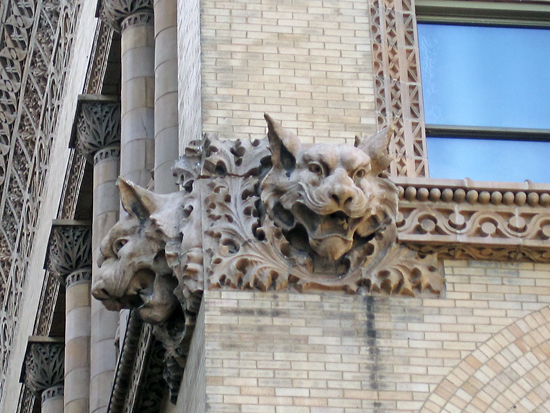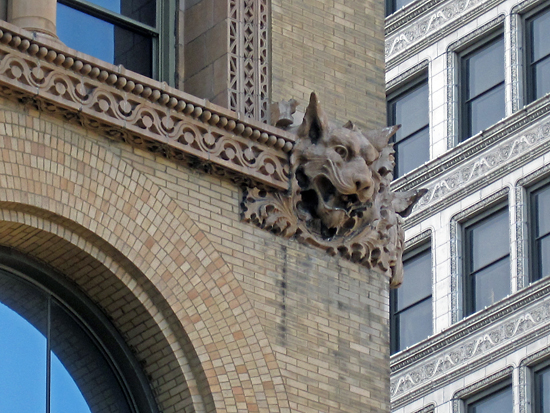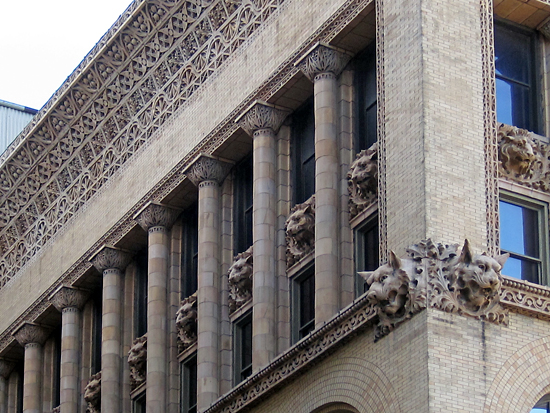 705 Olive Street
705 Olive Street
Downtown St. Louis, MO
St. Louis has an 1893 Louis Sullivan and Dankmar Adler building on the National Register, the Wainwright Building, which ranks as either the first or second (depending on whose counting) skyscraper built. Not as well known (even to my Architectural History & Theory teacher in college!) is that we have a second Sullivan & Adler building that survives to this day. On the northwest corner of 7th & Olive is the building which was designed as the Union Trust Building. Starting in 1902 it began a series of name changes: St. Louis Union Trust, Missouri Trust, Central National Bank, Lincoln Trust, and finally, to the name on its National Historic Landmark plaque, The 705 Building.
It also went through some serious remodeling, including a 1905 addition by Eames & Young on the north end of the building. But the most heinous crime was a 1924 remuddle which scrapped off the exterior of the first two floors. Here’s what it looked like from 1893 to about 1923.
Aside from the circular windows that still survive on the alley side of the building, the upper 13 stories have remained intact, including the lions shown above.
Typically, I dislike parking garages. But when the roof of a parking garage puts me this close to my beloved lions, then I really dig this parking garage, and don’t mind having had to pay $5 to use it!
To the right in the above photo is the Railway Exchange building, where I worked for Famous Barr advertising for 13.5 years. For half that time, we were on the 8th floor, and the Advertising President’s office looked down on these two lions. The the fool sat with his back to them!
When he was out, I’d sneak into his office to gaze lovingly at them; they were both inspirational and a sedative for deadline stress. They also got me in trouble when I was caught hanging out the President’s window with a camera, trying to get a shot without a dirty window between me and the lions.
And now 10 years later, a parking garage that I was forced to use on a Sunday afternoon has given me the closest, clearest access to all the lions. It was the best kind of September Sunday St. Louis Serendipity!



As a sculptor and collector of architectural pieces like these, I’m amazed at the sheer scale as well as depth of these sculptures, they are by far the largest and deepest of this type Ive ever seen.
The lion head is one piece and the surrounding leaves are at least 7 individual blocks.
The assembly is a good five to six feet across, and about that high, the pieces are embedded into the brick wall at least 10-12″ behind what you can see.
Ryan said;
“I’m currently conducting research to find out if the current building management or the remains of the old architectural firm have the original moulds of the lions”
I can tell you now, that there are no molds around and are long gone decades ago- they were very large very heavy plaster of paris molds made in multiple sections, the molds wear out and get damage quickly and the vast majority of these ornaments were custom made for each building and rarely ever re-used on other buildings.
A sculptor had to sculpt an original clay model of the lion and all 7 adjacent pieces for it, and about 10-15% LARGER to compensate for clay shrinkage.
Once the model was approved they made a multi piece plaster mold off it, but it was not just ONE mold, it was a multi piece plaster mold for EACH of the 7 sections and the lion, so it took 8 molds to make the lions.
These kinds of ornaments went way out of style by 1940 and the companies that made them shut their doors by then, so these items except for VERY expensive restorations- have not been commercially produced for new building facades in like 75 years!
(“A real mould could be made I suppose off of the side of the building, but would be an exorbitant expense)”
Forget any idea of replicating one of these, it won’t happen! they look big on the facade but put up a scaffold and stand next to one and you’ll see how impossible they will be to replicate.
I currently work in the REX directly across from the lions. I look at them every day in astonishment and admiration. My office is about to move to Washington St and I’m somewhat desperate to bring the lions with me. I’ve been taking a series of photos and plan to hang them in the new offices.
I’m currently conducting research to find out if the current building management or the remains of the old architectural firm have the original moulds of the lions. I’m also thinking of trying a 3D camera with a 3D printer to see if I can reproduce them. (A real mould could be made I suppose off of the side of the building, but would be an exorbitant expense)
Amy information you can provide would be appreciated.
Best
Ryan
Pingback: The Good Fortune of the Chemical Building | Preservation Research Office
I, too, loved sneaking into the President’s office during my Famous-Barr (and later Macy’s) advertising tenure just to get a look at the lions. Because of weather conditions, changing shadows, etc., they seemed to have many different expressions and I wanted to see them all. That meant I had to sneak in there A LOT. Wish I’d thought to hang out the window with a good ol’ Polaroid.
O’ man, the terra cotta and the brick work on this building KILLS! I need to replace my Landmarks “705” shirt, though. Getting a little threadbare.
You’ll be jealous of me. I work in 705 and make a couple of trips to the Wainwright Bldg for court. I literally bounce between the two all day long.